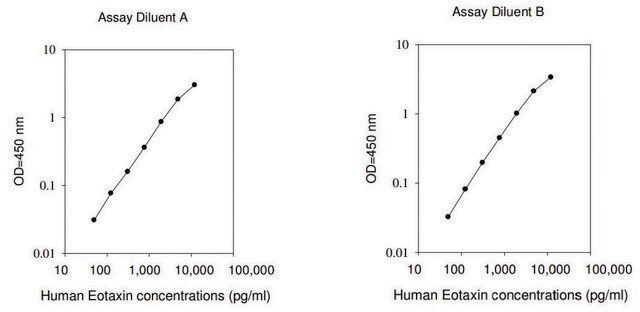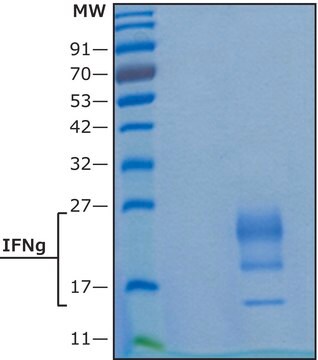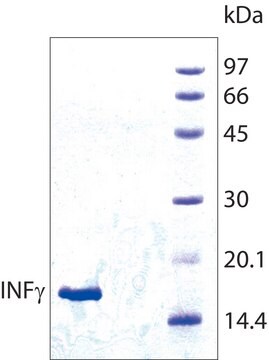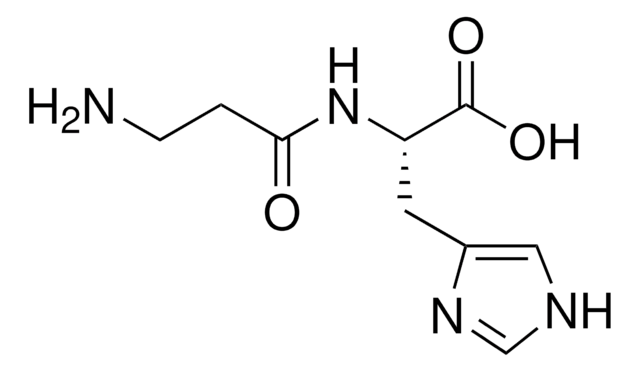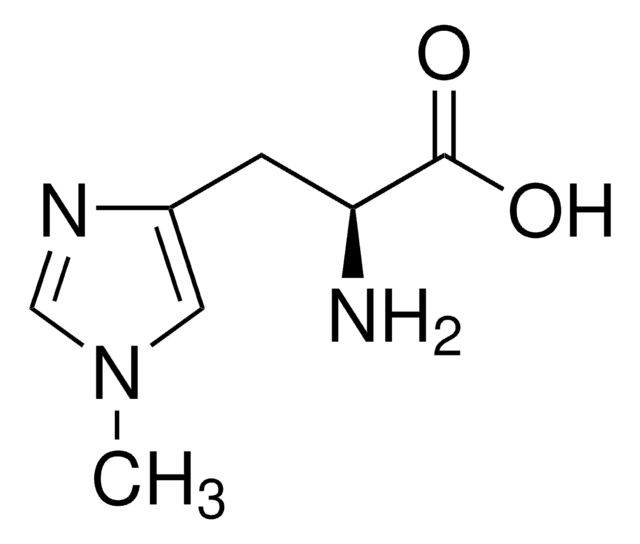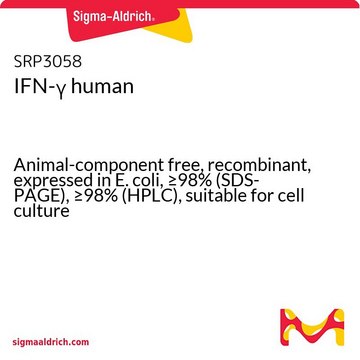E8399
Eotaxin-3 human
>97% (SDS-PAGE), recombinant, expressed in E. coli, lyophilized powder, suitable for cell culture
Synonyme(s) :
CCL26, SCYA26
Se connecterpour consulter vos tarifs contractuels et ceux de votre entreprise/organisme
About This Item
Produits recommandés
Source biologique
human
Niveau de qualité
Produit recombinant
expressed in E. coli
Essai
>97% (SDS-PAGE)
Forme
lyophilized powder
Puissance
0.25-1.0 mg
Poids mol.
~8.2 kDa
Conditionnement
pkg of 25 μg
Conditions de stockage
avoid repeated freeze/thaw cycles
Technique(s)
cell culture | mammalian: suitable
Impuretés
endotoxin, tested
Numéro d'accès UniProt
Température de stockage
−20°C
Informations sur le gène
human ... CCL26(10344)
Description générale
Eotaxin-3, also known as CCL26 or SCYA26, is a human CC chemokine and a functional ligand for CC chemokine receptor 3. This gene is localized to human chromosome 7q11.2, which codes for a protein of 71 amino acids. It belongs to the small inducible cytokine subfamily A , which also includes eotaxin and eotaxin-2.
Actions biochimiques/physiologiques
Eotaxin-3 is a potent attractant of eosinophils, and might be responsible for the accumulation of eosinophils in atopic diseases. As it is involved in the recruitment of eosinophils in inflammatory diseases, it, along with its receptor, might have potential as therapeutic target in inflammatory disorders, such as asthma. Demethylation results in increased expression of this gene, which in turn influences allergic reactions. This gene is overexpressed in bullous pemphigoid (BP), which results in the accumulation of eosinophils in skin lesions, thus, contributing to the pathogenesis of BP. Its expression is also elevated in the active lesions of patients with ulcerative colitis (UC) and Crohn′s disease (CD). Thus, it might play a role in the pathogenesis of UC, where its major source is colonic myofibroblasts.
Eotaxin-3, also known as CCL26 or SCYA26, is a human CC chemokine and a functional ligand for CC chemokine receptor 3. Mature recombinant human eotaxin-3 has a molecular mass of approximately 8.2 kDa and demonstrates chemotactic activity for eosinophils.
Forme physique
Lyophilized from a 0.2 μm filtered solution in 30% acetonitrile and 0.1% trifluoroacetic acid containing 1.25 mg bovine serum albumin.
Remarque sur l'analyse
The biological activity is measured by its ability to induce chemotaxis of rat Y3 cells stably expressing hCCR3.
Mention d'avertissement
Warning
Mentions de danger
Conseils de prudence
Classification des risques
Acute Tox. 4 Inhalation - Eye Irrit. 2
Code de la classe de stockage
11 - Combustible Solids
Classe de danger pour l'eau (WGK)
WGK 2
Point d'éclair (°F)
Not applicable
Point d'éclair (°C)
Not applicable
Faites votre choix parmi les versions les plus récentes :
Déjà en possession de ce produit ?
Retrouvez la documentation relative aux produits que vous avez récemment achetés dans la Bibliothèque de documents.
Eunjin Lim et al.
Journal of immunology (Baltimore, Md. : 1950), 192(1), 466-474 (2013-12-11)
DNA demethylation has been primarily studied in the context of development biology, cell fate, and cancer, with less attention on inflammation. In this article, we investigate the association between DNA methylation and production of the chemoattractant cytokine eotaxin-3 in the
M Kitaura et al.
The Journal of biological chemistry, 274(39), 27975-27980 (1999-09-17)
Previously, we mapped the novel CC chemokine myeloid progenitor inhibitory factor 2 (MPIF-2)/eotaxin-2 to chromosome 7q11.23 (Nomiyama, H., Osborne, L. R., Imai, T., Kusuda, J., Miura, R., Tsui, L.-C., and Yoshie, O. (1998) Genomics 49, 339-340). Since chemokine genes tend
C Günther et al.
Clinical and experimental immunology, 166(2), 145-153 (2011-10-12)
Eosinophils contribute to the pathogenesis of bullous pemphigoid (BP) by secretion of proinflammatory cytokines and proteases. Trafficking of eosinophils into tissue in animal models and asthma depends on interleukin-5 and a family of chemokines named eotaxins, comprising CCL11, CCL24 and
R F Guo et al.
Genomics, 58(3), 313-317 (1999-06-22)
By searching the Expressed Sequence Tag database, a full-length cDNA for a novel human CC chemokine was cloned. This cDNA encoded a 94-amino-acid protein with a putative signal peptide of 26 amino acids. The deduced mature protein had the four
A Shinkai et al.
Journal of immunology (Baltimore, Md. : 1950), 163(3), 1602-1610 (1999-07-22)
IL-4 has been shown to be involved in the accumulation of leukocytes, especially eosinophils, at sites of inflammation by acting on vascular endothelial cells. To identify novel molecules involved in the IL-4-dependent eosinophil extravasation, cDNA prepared from HUVEC stimulated with
Notre équipe de scientifiques dispose d'une expérience dans tous les secteurs de la recherche, notamment en sciences de la vie, science des matériaux, synthèse chimique, chromatographie, analyse et dans de nombreux autres domaines..
Contacter notre Service technique